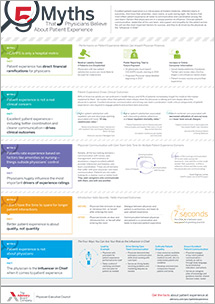Auto logout in seconds.
Continue LogoutWriting for WBUR, Clement Bottino, a pediatrician at Boston Children's Hospital, explains why he gives his patients his personal cellphone number—a practice that he describes as "invigorating, the opposite of burnout."
5 myths physicians believe about patient experience
Why this physician chooses to give his number to patients
Bottino has been giving his cellphone number to thousands of patients since 2009 when he started his practice. Texting, Bottino said, allows him to address patient questions or concerns he might not be able to address in the standard 15-minute appointment.
"Most of my paid clinical time is spent rushing through 15-minute visits and slogging through electronic paperwork," Bottino writes. But with texting, he writes, "the rush disappears. Patients can text me when they want ... I can answer questions, put worried parents' minds at ease and prevent unnecessary ED visits."
While the practice is far from standard, research shows Bottino is not alone in his preference to text patients: Small studies show that more than half of physicians use text messaging to convey clinical communications, according to a 2017 JAMA viewpoint. Bottino notes texting also is in line with federal privacy regulations. He cites the JAMA viewpoint, which states, "texting to communicate health information is neither explicitly prohibited by HHS nor illegal in the United States."
Why texting is 'the opposite of burnout'
"[M]y family and colleagues often question my work-life balance," he writes. Further, he confesses, "I sometimes worry that the thousand or so patients who have my number will all text me at once."
But in practice, Bottino receives an average of about six text messages per day. In 2018, patients sent Bottino 2,097 texts, and in response, he sent almost 2,000 texts.
Some of the texts were clinical, with pictures of things like swollen gums and rashes.
But others were personal, Bottino notes. "They sent videos of babies breathing noisily and taking their first steps." Sometimes the patients sent him emojis and selfies; some even sent "turkeys on thanksgiving" and heart-shaped stethoscopes on Doctor's Day," he writes.
He explains how sharing his number with the parents of all of his young patients allows him to establish, and often maintain, relationships with his patients and their families. "At the birth of a sibling, patients send me photos of their new addition," Bottino writes "In illness and death, we remain connected."
One connection he maintained over the years is with the mother of a young patient named Rae, who had a tumor on her kidney. After years of treatment, Rae's tumor kept growing back and eventually spread. When Bottino visited Rae in the hospital, he asked Rae's mother if Rae would want to FaceTime with his daughter. "She said yes," Bottino writes. His daughter, age five, spent half an hour on FaceTime with Rae.
They arranged several more FaceTime play dates for their daughters before Rae died. Bottino and his family attended Rae's funeral, where Rae's mother thanked his daughter for "bringing Rae so much joy."
When Bottino ran into Rae's mother a while later, he found that the connection they established over text remained. "I told her I think of Rae often, and her eyes filled with tears. 'Maybe some time,' I said, 'your family can stop by our home for cookies and coffee.'"
Rae's mother responded, "'Yes …. I'll text you,'" Bottino writes (Bottino, WBUR, 3/22; Drolet, JAMA viewpoint, 6/20/17).
5 myths physicians believe about patient experience
Excellent patient experience is a critical piece of modern medicine, reflected clearly in outcomes. And more than amenities, clean rooms, or quiet during night, the factors that most inflect patient experience all relate to communication and coordination among the care team—factors that physicians are in a unique position to influence.
Clinician-patient communication, leadership of the care team, and support and empathy for the patient across the unit are the most important factors for success, and they're all driven by the physician as the "Influencer in Chief."
Don't miss out on the latest Advisory Board insights
Create your free account to access 1 resource, including the latest research and webinars.
Want access without creating an account?
You have 1 free members-only resource remaining this month.
1 free members-only resources remaining
1 free members-only resources remaining
You've reached your limit of free insights
Become a member to access all of Advisory Board's resources, events, and experts
Never miss out on the latest innovative health care content tailored to you.
Benefits include:
You've reached your limit of free insights
Become a member to access all of Advisory Board's resources, events, and experts
Never miss out on the latest innovative health care content tailored to you.
Benefits include:
This content is available through your Curated Research partnership with Advisory Board. Click on ‘view this resource’ to read the full piece
Email ask@advisory.com to learn more
Click on ‘Become a Member’ to learn about the benefits of a Full-Access partnership with Advisory Board
Never miss out on the latest innovative health care content tailored to you.
Benefits Include:
This is for members only. Learn more.
Click on ‘Become a Member’ to learn about the benefits of a Full-Access partnership with Advisory Board
Never miss out on the latest innovative health care content tailored to you.


